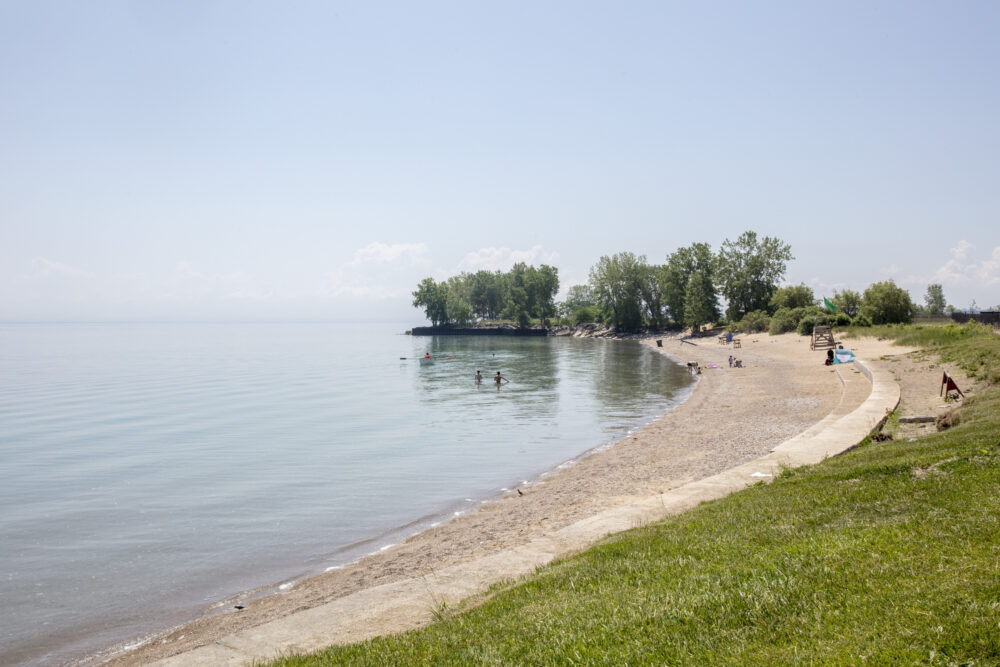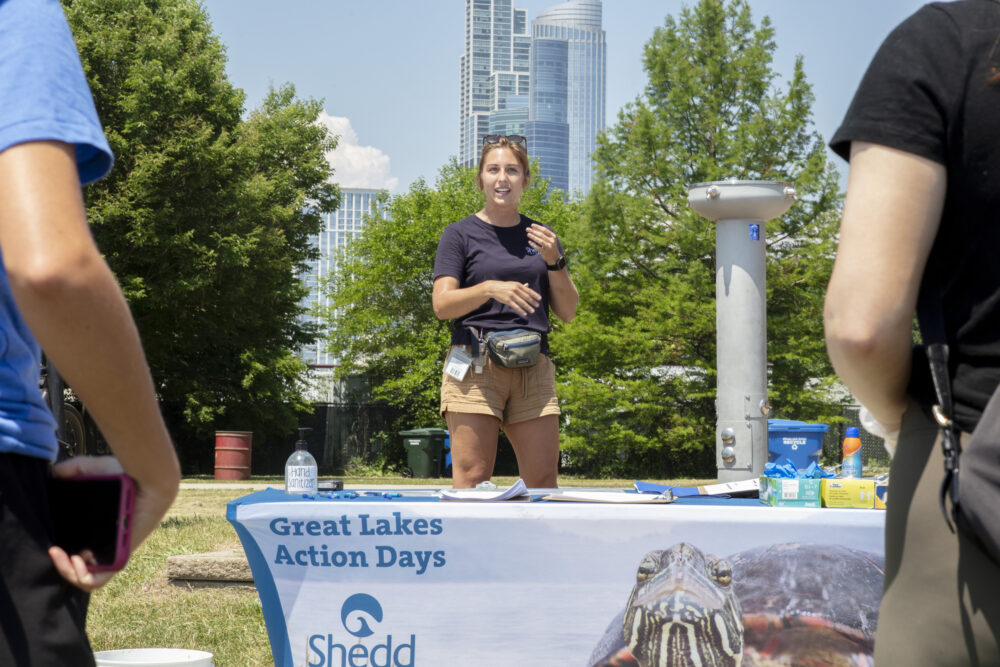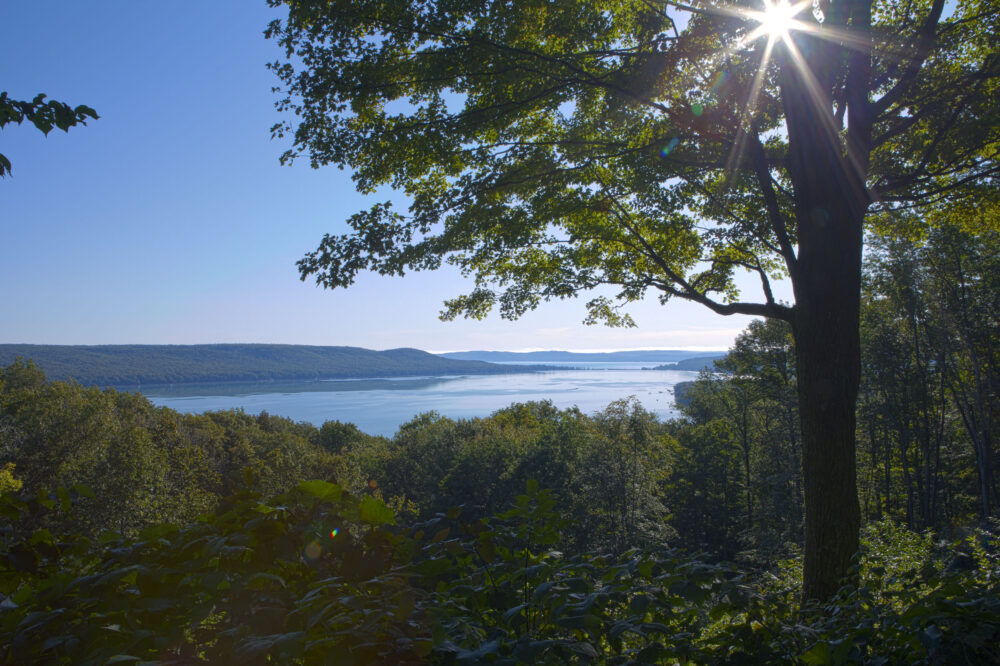The Great Lakes Named Mission Blue’s First Freshwater Hope Spot
May 17, 2023
Featured image: Aerial view of Sleeping Bear Dunes © Shedd Aquarium
(LAKE MICHIGAN, CHICAGO, UNITED STATES) –
International marine conservation nonprofit Mission Blue has named the Great Lakes the first and only freshwater Hope Spot with the John G. Shedd Aquarium in Chicago, Illinois, as the Hope Spot Champion.

Dr. Sylvia Earle, Founder of Mission Blue, posed a challenge to Shedd Aquarium last April to consider the Great Lakes for designation, in part, due to the unique connectivity they share with marine environments and human health. “The Great Lakes represent both the figurative and the literal heart of the North American water system,” Dr. Earle stated. “A source of water for over 40 million people and more than 3,500 plant and animal species, many of which are unique to the Great Lakes, the inclusion of this critically important natural area as a Hope Spot will highlight the connection and significance of protecting inland habitats, as we really understand that the whole aquatic world; inland waters and the ocean beyond are one interconnected system.”
The Great Lakes span more than 750 miles (1,207 kilometers) and are straddled across the United States’ north-central border and Canada’s south-central border. The five bodies of water that make up the Great Lakes are Lake Superior, Lake Michigan, Lake Huron, Lake Erie, Lake Ontario and their connecting channels, including the St. Lawrence River. The massive lakes hold approximately 90% of the freshwater in the United States and 21% of the world’s surface freshwater supply. Unfortunately, freshwater habitats are experiencing declines in biodiversity far greater than those in the most affected terrestrial ecosystems (Dudgeon et al. 2006).

Bridget Coughlin, PhD, President and CEO of Shedd Aquarium, says, “The Great Lakes serve as a vital economic driver, natural resource and place of respite for millions of people across two countries.” She continues, “By size alone, we know that conserving such a great and important source of sustainability and sustenance cannot be done alone. Hope Spot designations not only bring awareness and focus to areas in need of environmental protection and recovery, but also critical collaboration that can help influence policy change, motivate economic shifts and generate a global wave of community support for aquatic conservation.”

Several local, regional, national and international partners supported the bid from Shedd Aquarium to make the Great Lakes a Hope Spot. These partners include Alliance for the Great Lakes, Aquarium of Niagara, Audubon Great Lakes, Buffalo Zoo, Chicago Park District, Cleveland MetroParks Zoo, Cook County Board of Commissioners, Cook County Department of Environment and Sustainability, The Detroit Zoological Society which runs the Detroit Zoo and the Belle Island Nature Center, Discovery World Science + Technology Center, Friends of the Chicago River, The Great Lakes and St. Lawrence Cities Initiative, Great Lakes Fishery Commission, Haerther Scholars, Healing Our Waters: Great Lakes Coalition, National Marine Sanctuary Foundation, National Wildlife Federation – Great Lakes Regional Center, Openlands, Rep. Danny Davis – U.S. House of Representatives, Rep. Robyn Gabel – Illinois State House of Representatives, Sen. Robert Peters – Illinois State Senate, SC Johnson, Timothy Hoellein – Loyola University Department of Biology, Toronto Zoo and the UIC Freshwater Lab.

The conservation and accessibility of freshwater is an ever-growing issue. Threats to the Great Lakes are consistent with those historically faced by most aquatic ecosystems worldwide: habitat loss and degradation, pollution, invasive species, overexploitation and flow modification (Dudgeon et al. 2006). Modern threats have emerged, including pesticides that cause harmful algal blooms, microplastics and a rapidly changing global climate (Ried et al. 2018). Additionally, urbanization and a lack of connectedness to nature can exacerbate the threats to these natural resources, as many people do not regard the Great Lakes as a habitat for diverse aquatic life (Murchie et al. 2018).

Kristen Sarri, president and CEO at National Marine Sanctuary Foundation expresses the importance of developing formal protection for freshwater entities. “There are ‘representation gaps’ as currently MPAs are not representative of all types of habitats or ecosystems found in U.S. waters and there are ‘ecological gaps’ where key species, habitats, or ecosystems are missing. Freshwater biodiversity protection is also some of the most underrepresented globally. [The recognition of] the entirety of the Great Lakes as a Hope Spot can help to bridge these gaps.”
Despite environmental challenges, the Great Lakes are also a fantastic example of what can be accomplished through both local and binational collaboration, but the work must continue to ensure an equitable, sustainable and thriving future for both people and aquatic life.

The Great Lakes are home to a variety of endemic species such as fish, mollusks, invertebrates, birds, and mammals as well as oceanic species that either permanently or temporarily reside in the lakes, primarily birds and certain species of fish, including the coho salmon (Oncorhynchus kisutch) and king salmon (Oncorhynchus tshawytscha). Due to habitat loss and degradation, nearly half of the more than 30 amphibian species native to the Great Lakes basin fall into a category of conservation concern ranging from special concern, threatened, endangered, and extirpated. Endemic species include lake trout (Salvelinus namaycush) and lake sturgeon (Acipenser fulvescens), as well as critically endangered and possibly extinct species such as certain varieties of cisco.

“The Great Lakes region is an incredible natural resource. Protecting and ensuring a healthy and vibrant Great Lakes is critical to the health of our planet for both this and future generations,” said Fisk Johnson, Chairman and CEO of SC Johnson.
Mission Blue, Shedd Aquarium and Great Lakes partner organizations encourage the public to learn more here and sign up to stay connected to Hope Spot efforts and receive ways to participate and act as champions of hope for the Great Lakes.
About Shedd Aquarium
The John G. Shedd Aquarium in Chicago sparks compassion, curiosity, and conservation for the aquatic animal world. Home to 32,000 aquatic animals representing 1,500 species of fishes, reptiles, amphibians, invertebrates, birds, and mammals from waters around the globe, Shedd is a recognized leader in animal care, conservation education, and research. An accredited member of the Association of Zoos & Aquariums (AZA), the organization is an affiliate of the Smithsonian Institution and supported by the people of Chicago, the State of Illinois, and the Chicago Park District. www.sheddaquarium.org








This is such inspiring and welcome news! It is VITAL that legislators agencies and the public begin to understand how important are these unique bodies of water and thanks go to all those who worked so hard to bring about this happy result. Good for ALL! How refreshing and how spectacular !! THANK YOU!